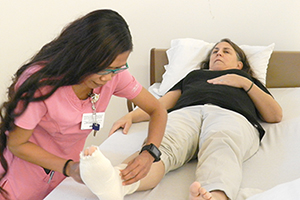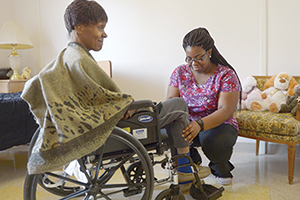By RENEE STOVSKY
Karen Williams, 42, has been injury-free in the year plus she's worked as a care partner, or nursing assistant, at the Jennings nursing home in Garfield Heights, Ohio. At her previous job, she wrenched her back when she lifted a patient the wrong way.
"It was not a good feeling; I had to take a week off — and a lot of medication — before I could go back to work," she remembers.
Her colleague, Lori Price, 57, has been a care partner at Jennings for 13 injury-free years. "I'd like to try to keep it that way," she says.

Jennings care partner Ana Rose Dygert, left, demonstrates to instructor Debbie Espy, that she has learned to avoid injury while putting on a resident's compression stocking. Dygert first raised the bed to prevent excess bending of her back. Espy, an associate professor at Cleveland State University School of Health Sciences, poses as the resident. Dygert wears a smart watch that vibrates to cue her when she moves unsafely.
Photo by Gary Harwood
That's why both Williams and Price volunteered for a recent study at Jennings conducted by Cleveland State University that uses a Kinect motion sensing camera, similar to those used by Nintendo's Wii home video consoles, to improve worker safety. The study, funded by a $243,000 Ohio
occupational safety and health research grant from the Ohio Bureau of Workers' Compensation, aims to reduce the risk of injury among care partners by alerting them when they do not use correct body mechanics while engaged in bedside care activities.
Gaming platform
The collaboration between Cleveland State and Jennings is a natural one, says Glenn Goodman, Cleveland State professor and associate director of the School of Health Sciences' master of occupational therapy program there.
The school, he explains, has a motion analysis lab that uses inertial sensor technology to give clients, such as stroke patients, feedback on movement. Several Cleveland State faculty members — including Wenbing Zhao, professor of electrical engineering and computer science; Ann Reinthal, associate professor, program of physical therapy and director of the motion analysis lab; and Debbie Espy, associate professor, program of physical therapy — have been interested in innovative ways to use the gaming platform software in a less expensive, more mobile product to provide real-time feedback on lifting, bending, rotating and other body movements to health care workers, who have high rates of back injuries.
Injury reduction by design
Jennings, meanwhile, has been involved in a safe movement program since 2006, when it became a pilot site for a Kent State University research study that involved educating staff in ergonomic principles and installing electric ceiling lifts, fast-rising high/low electric beds and sit-to-stand lifts in its long-term care residence.
"Our data shows a 75 percent reduction in injury among health care workers as a result of lifting or transferring residents since we participated in that study," says Allison Q. Salopeck, president and chief executive at Jennings. "We know that creating safe working conditions through safe movement practice and technology can help keep nurses and nursing assistants employed for longer periods of time."

By lowering her center of gravity and working between her shoulders and knees, Jennings care partner Evonne Ervin avoids back strain and conserves energy while helping resident Gloria Brown get dressed. Ervin wears a smart watch that vibrates to cue her when she moves unsafely.
Photo by Gary Harwood
Salopeck adds that Jennings — established in 1942 through a bequest from Msgr. Gilbert Jennings and sponsored by the Sisters of the Holy Spirit through the Cleveland diocese — serves more than 1,000 seniors annually by providing a range of aging services, from independent and assisted living apartments to adult day care, short-term rehab, hospice and home care. But nursing home care presents a special challenge for the future, she says.
"The growth in the number of older people in the next several decades, coupled with the realities of a shrinking workforce, will place extraordinary stress on the long-term care system at the same time the demand for high-quality nursing home care will be the greatest," says Salopeck. "Anything we can do to reduce the occurrence of musculoskeletal injuries — injuries that could cause our dedicated nursing staff to leave their careers prematurely — is of great interest to us."
Bend and lift
Work on the Cleveland State research project actually began in 2015, with feasibility and retrofitting studies of the Kinect monitoring system and the production of instructional videos, produced by an external partner, occupational therapist Steve Vojtko, of Health and Occupational Preventive Solutions.
Last October more than 200 Jennings employees participated in "Fall Frenzy" educational sessions that included classes on ergonomics, an orientation to the Kinect system for body mechanics, and competency testing on the use of ceiling lifts, transfer belts and sit-to-stand lifts. Cleveland State students attended as well, standing in as skilled nursing facility "residents" for the competency training.
After the event, the Kinect system was installed in five resident rooms, and seven care partners were recruited to participate in the actual study — three on morning shifts, three on afternoon shifts and one at night. They attended a training session in January to learn how to operate the system and to review proper techniques for activities such as donning compression stockings, moving a resident in bed and specialized bathing techniques for bedbound residents.
Basically, the Kinect system consists of a motion sensing camera, which is connected to a smart watch via a laptop computer and cell phone. The camera records data of the positions of a single person's body segments and joints to assess that person's posture and movements. When the system recognizes that the participating care partner has moved in an unsafe manner or is holding an unsafe posture, it sends an alert, via a vibration, to a smart watch she or he is wearing. It also records what the unsafe motion was, when it occurred, and that the alert was sent.
Instant feedback
Once the Kinect system was operational, Goodman and his Cleveland State associates collected data, without providing feedback, for a week to obtain baseline readings. Participating nurse assistants then wore their smart watches for a two-month interval, to receive real-time feedback via vibrations while they were performing their regular duties. After that time, Cleveland State collected data again, without providing feedback, to obtain a post-training baseline. (The care partners received the smart watches as a gift, along with a $100 gift card for participating in the project.)
At first, there was some hesitancy on the part of participants, says Jennifer Pazey, a licensed practical nurse who is coordinator on the "neighborhood" where the study was conducted. "No one wanted to get in trouble; they were worried about where the data was going to go," she says. "Once they were reassured that this was just for research, they relaxed and appreciated the reminders as a helpful tool for safe movement. After all, a vibration on the wrist is a more gentle criticism than an actual person who corrects you."
"At first I got 12 to 14 vibrations each shift, like when I was making the bed and I bent over too far," says Price. "It reminded me I had to stand up and let the bed up higher."
Adds Williams: "It made me aware to be more careful, whether I was reaching over to grab a remote or bending down to put someone's shoes on. It was good reinforcement and a really good experience."
Safer, smarter, faster, harder
Though the baseline data is still being analyzed, Salopeck says she sees the Kinect system as a good training tool to use in annual clinical reeducation programs. "Instead of having people sit at a table and be told to bend their knees when they bend over, it's a hands-on way to remind them how to use good body mechanics while doing everyday tasks," she says.
Ultimately, Goodman hopes the Kinect system will have the potential to help alleviate the growing shortage of nursing help in long-term care by reducing work-related injuries.
"We are keeping people alive longer, but they are living with a higher load of disability, and often higher rates of obesity. At the same time, our pool of nursing care workers is shrinking — and aging. And work expectations have increased; nurses have to work smarter, faster and harder to care for more residents than ever before," he says.
"It's critical to create safe working conditions to avoid unnecessary injuries, reduce turnover and increase career spans for caregivers. Technologies like the Kinect system can play a positive role toward reaching that goal," he says.
Copyright © 2017 by the Catholic Health Association
of the United States
For reprint permission, contact Betty Crosby or call (314) 253-3490.